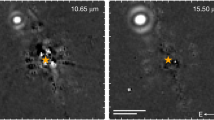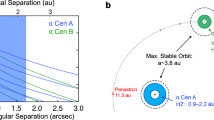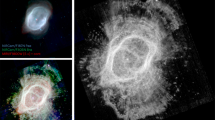Abstract
High-contrast near-infrared imaging of the nearby star HR 8799 has shown three giant planets1. Such images were possible because of the wide orbits (>25 astronomical units, where 1 au is the Earth–Sun distance) and youth (<100 Myr) of the imaged planets, which are still hot and bright as they radiate away gravitational energy acquired during their formation. An important area of contention in the exoplanet community is whether outer planets (>10 au) more massive than Jupiter form by way of one-step gravitational instabilities2 or, rather, through a two-step process involving accretion of a core followed by accumulation of a massive outer envelope composed primarily of hydrogen and helium3. Here we report the presence of a fourth planet, interior to and of about the same mass as the other three. The system, with this additional planet, represents a challenge for current planet formation models as none of them can explain the in situ formation of all four planets. With its four young giant planets and known cold/warm debris belts4, the HR 8799 planetary system is a unique laboratory in which to study the formation and evolution of giant planets at wide (>10 au) separations.
This is a preview of subscription content, access via your institution
Access options
Subscribe to this journal
Receive 51 print issues and online access
$199.00 per year
only $3.90 per issue
Buy this article
- Purchase on SpringerLink
- Instant access to full article PDF
Prices may be subject to local taxes which are calculated during checkout




Similar content being viewed by others
References
Marois, C. et al. Direct imaging of multiple planets orbiting the star HR 8799. Science 322, 1348–1352 (2008)
Kuiper, G. P. On the origin of the Solar System. Proc. Natl Acad. Sci. USA 37, 1–14 (1951)
Mizuno, H. Formation of the giant planets. Prog. Theor. Phys. 64, 544–557 (1980)
Su, K. Y. L. et al. The debris disk around HR 8799. Astrophys. J. 705, 314–327 (2009)
Moór, A. et al. Nearby debris disk systems with high fractional luminosity reconsidered. Astrophys. J. 644, 525–542 (2006)
Torres, C. A. O., Quast, G. R., Melo, C. H. F. & Sterzik, M. F. in Handbook of Star Forming Regions Vol. II, The Southern Sky (ed. Reipurth, B.) 757–812 (ASP Monograph Publications, MP 005, 2008)
Golimowsky, D. A. et al. L' and M' photometry of ultracool dwarfs. Astrophys. J. 127, 3516–3536 (2004)
Hinz, P. M. et al. Thermal infrared MMTAO observations of the HR 8799 planetary system. Astrophys. J. 716, 417–426 (2010)
Janson, M., Bergfors, C., Goto, M., Brandner, W. & Lafrenière, D. Spatially resolved spectroscopy of the exoplanet HR 8799 c. Astrophys. J. 710, L35–L38 (2010)
Bowler, B. P., Liu, M. C., Dupuy, T. J. & Cushing, M. C. Near-infrared spectroscopy of the extrasolar planet HR 8799 b. Astrophys. J. 723, 850–868 (2010)
Goz´dziewski, K. & Migaszewski, C. Is the HR 8799 extrasolar system destined for planetary scattering? Mon. Not. R. Astron. Soc. 397, L16–L20 (2009)
Reidemeister, M. et al. A possible architecture of the planetary system HR 8799. Astron. Astrophys. 503, 247–258 (2009)
Fabrycky, D. C. & Murray-Clay, R. A. Stability of the directly imaged multiplanet system HR 8799: resonance and masses. Astrophys. J. 710, 1408–1421 (2010)
Chambers, J. E. A hybrid symplectic integrator that permits close encounters between massive bodies. Mon. Not. R. Astron. Soc. 304, 793–799 (1999)
Dodson-Robinson, S. E., Veras, D., Ford, E. B. & Beichman, C. A. The formation mechanism of gas giants on wide orbits. Astrophys. J. 707, 79–88 (2009)
Kratter, K. M., Murray-Clay, R. A. & Youdin, A. N. The runts of the litter: why planets formed through gravitational instability can only be failed binary stars. Astrophys. J. 710, 1375–1386 (2010)
Stamatellos, D. & Whitworth, A. P. The properties of brown dwarfs and low-mass hydrogen-burning stars formed by disc fragmentation. Mon. Not. R. Astron. Soc. 392, 413–427 (2009)
Lafrenière, D. et al. The Gemini Deep Planet Survey. Astrophys. J. 670, 1367–1390 (2007)
Nielsen, E. & Close, L. M. A uniform analysis of 118 stars with high-contrast imaging: long-period extrasolar giant planets are rare around Sun-like stars. Astrophys. J. 717, 878–896 (2010)
Chauvin, G. et al. Deep imaging survey of young, nearby austral stars. VLT/NACO near-infrared Lyot-coronagraphic observations. Astron. Astrophys. 509, A52–A68 (2010)
Rhee, J. H., Song, I., Zuckerman, B. & McElwain, M. Characterization of dusty debris disks: the IRAS and Hipparcos catalogs. Astrophys. J. 660, 1556–1571 (2007)
Marois, C., Lafrenière, D., Doyon, R., Macintosh, B. & Nadeau, D. Angular differential imaging: a powerful high-contrast imaging technique. Astrophys. J. 641, 556–564 (2006)
Lafrenière, D., Marois, C., Doyon, R., Nadeau, D. & Artigau, É. A new algorithm for point-spread function subtraction in high-contrast imaging: a demonstration with angular differential imaging. Astrophys. J. 660, 770–780 (2007)
Marois, C., Macintosh, B. & Véran, J.-P. Exoplanet imaging with LOCI processing: photometry and astrometry with the new SOSIE pipeline. Proc. SPIE 7736, 77361J–77361J-12 (2010)
Baraffe, I., Chabrier, G., Barman, T. S., Allard, F. & Hauschildt, P. H. Evolutionary models for cool brown dwarfs and extrasolar giant planets. The case of HD 209458. Astron. Astrophys. 402, 701–712 (2003)
Eggenberger, A. & Udry, S. Detection and characterization of extrasolar planets through Doppler spectroscopy. EAS Publ. Ser. 41, 27–75 (2010)
Moya, A. et al. Age determination of the HR8799 planetary system using asteroseismology. Mon. Not. R. Astron. Soc. 405, L81–L85 (2010)
Gáspár, A. et al. The low level of debris disk activity at the time of the late heavy bombardment: a Spitzer study of Praesepe. Astrophys. J. 697, 1578–1596 (2009)
Marley, M. S., Fortney, J., Hubickyj, O., Bodenheimer, P. & Lissauer, J. J. On the luminosity of young Jupiters. Astrophys. J. 655, 541–549 (2007)
Malhotra, R. in Solar System Formation and Evolution (eds Lazzaro, D., Vieira Martins, R., Ferraz-Mello, S. & Fernandez, J.) 37–63 (ASP Conf. Ser. Vol. 149, 1998)
Acknowledgements
We thank the Keck staff, particularly H. Lewis, B. Goodrich and J. Lyke, for support with the follow-up observations. We thank G. Laughlin and D.C. Fabrycky for discussions. Portions of this research were performed under the auspices of the US Department of Energy by LLNL and also supported in part by the NSF Center for Adaptive Optics. We acknowledge support by NASA grants to UCLA, LLNL and Lowell Observatory. The data were obtained at the W.M. Keck Observatory. This publication makes use of data products from the Two Micron All Sky Survey and the SIMBAD database.
Author information
Authors and Affiliations
Contributions
The authors contributed equally to this work.
Corresponding author
Ethics declarations
Competing interests
The authors declare no competing financial interests.
Supplementary information
Supplementary Information
The file contains Supplementary Tables 1-2 showing the stable configurations (30Myr and 60 Myr) found for the HR 8799 4-planet system. (PDF 107 kb)
Rights and permissions
About this article
Cite this article
Marois, C., Zuckerman, B., Konopacky, Q. et al. Images of a fourth planet orbiting HR 8799. Nature 468, 1080–1083 (2010). https://doi.org/10.1038/nature09684
Received:
Accepted:
Published:
Issue Date:
DOI: https://doi.org/10.1038/nature09684
This article is cited by
-
Detecting life outside our solar system with a large high-contrast-imaging mission
Experimental Astronomy (2022)
-
Adaptive optics for high-resolution imaging
Nature Reviews Methods Primers (2021)
-
A wide-orbit giant planet in the high-mass b Centauri binary system
Nature (2021)
-
Spitzer’s debris disk legacy from main-sequence stars to white dwarfs
Nature Astronomy (2020)
-
A system of super Jupiters
Nature Astronomy (2019)




